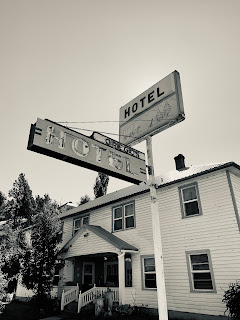Notes from a visit to Eastern Oregon
Oregon east-of-the-Cascades is a mystic, even ethereal place. Not much there, but so much hidden and so much to explore. I think this as I drive the Subaru out of Bend and Redmond toward who knows what or where. My brother from another mother – a chum I met back in college – rides shotgun.
Our usual mode of exploration transit involves two wheels attached to a righteous amount of horsepower. But this trip, in mid-September, found us nursing ailments – knees, backs, joint-related maladies – ailments we never really considered over the fifty years of our shared adventures.
The west’s Basin and Range, in the rain shadow of the Sierra and Cascades, is a mosaic of lodgepole, sage and pinion, basalt and dry washes and baking desert sun. It stretches all the way to the base of the Rockies. Seemingly desolate and unforgiving, most of us simply fly over from San Francisco or Seattle en route to Chicago, New York, London or any of a thousand historic destinations. Yet, in that jet-plane rush, we’re flying over history that began before time.
And during that ‘before time,’ the sea floor lifted and buckled to be shaved and carved by ice and wind. Lava oozed from fissures, flowed until cool, and solidified only to be broken into some semblance of dirt by freezing and thawing and the incessant labors of acidic lichens. Winds and rains pushed and scrubbed topsoil off prehistory’s basaltic base. Grasses, shrubs and, eventually, those pinions grabbed hold in protected crevasses. Luck probably played a hand. Luck plays a hand in a lot of life, doesn’t it?
Early man migrating across the Bering Strait during an ice age or two – or seven – left his subtle mark. Ten of thousands of years later, European settlers crossed, lured by the siren song of California’s fields of gold, groves of redwood and fir and soils rich for tillage. Cities were sure to follow.
Some folks trickled back. Those with a different dream or, perhaps, a recurring one. Looking for the next Mother Lode? Looking for the next verdant valley? Or simply looking. Remnants include rough-hewn cabins protected from rot by decades of arid drought. Fencelines run straight up hillsides begging the question, What was being fenced in or fenced out?
Rutted dirt two-track roads followed emigrant routes. Highways followed those. But off those highways, wading through the sage and yellow pine, traces of the steel tires of Conestoga wagons and primitive ox-drawn carts can still be found scratched into the land. One wonders how many head can graze on one’s 160 acre grant. Did they have the land grant program here? They sure as hell couldn’t depend on row crops or grain. There surely was no sod to bust.
We drive past a basalt bluff, one that looks like an 11th century Scottish Castle. (Note: I had visited a Scottish Castle only three weeks before.) The formation long preceded man and will live long after we’ve departed.
Etched into the base are the pointillist stories of the Utes or their predecessors. The message is probably simple, but we’re left only with conjecture. These humans were independent relying only upon their skill and wit and the stuff they learned from the prior generations. Let’s call that ‘history’ in its most basic of applications.
The contemporary folks who live out here, likewise, are independent souls. As my companion and I see signs in support of a presidential candidate he and I both disdain, a realization – or maybe just another conjecture – rises. These people depend first upon themselves and then their neighbors. In this lonesome territory, I suspect the sheriff is an hour or more away, as is the tractor repair guy. A trip to a big box store might consume a whole day. And you might not make it to the hospital in time. So the signs I may disdain might really be saying, Leave me the hell alone. I’ve got this. I’m good out here on the high lonesome. Followed, perhaps, by: You likely wouldn’t be. (In my case, they’d be right.) Hard working, rugged folks with well-honed views of things different from those of two guys cruising around these parts in some damned Subaru.
We pass through a small town, no bigger than a wink. Jean Baptiste Charbonneau may have come this way when relocating from Murderer’s Bar on California’s American River (near my one-time Placer County home) to the Idaho mines.
Up the road a bit we pause where the Bhagwan Shree Rajneesh escaped from India and set up a colony four decades back bringing with him seven Rolls Royces and much consternation.
Further on we visit a site where their-workday-is-done trucks rest scattered about a field like a graveyard, their once robust bodies dissolving into the sage, destined to be lost to history long before the aforementioned bluff.
Perhaps that is the one great lesson of Oregon’s high desert: never will we see it all or grasp the enormity of its time and space, but never should we stop trying.
o0o
This day’s route: US 97 north from Bend; OR 126 east to Prineville; US 26 to Mitchell (Charbonneau?); OR 207 north to Fossil (check out the John Day Fossil beds scattered through here); OR 218 west to Antelope (pop. 39 ~ former locale of the Shree Rajneesh); continue north to Shaniko (field of rusting vehicles, but, sadly, no trace of a Bhagwan’s Rolls); US 97 south to Bend.
Nearby? Oregon’s High Desert Museum about ten miles south of bend on US 97. All kinds of history! Plan on a half a day. Bring the youngin’s. https://highdesertmuseum.org
A bit further east? National Historic Oregon Trail Interpretive Center near Baker City, Oregon. Come see the privations immigrants endured and check out the wagon ruts still visible in solid stone. Allow another half day. https://www.blm.gov/learn/interpretive-centers/national-historic-oregon-trail-interpretive-center
© 2024
Church of the Open Road Press










No comments:
Post a Comment